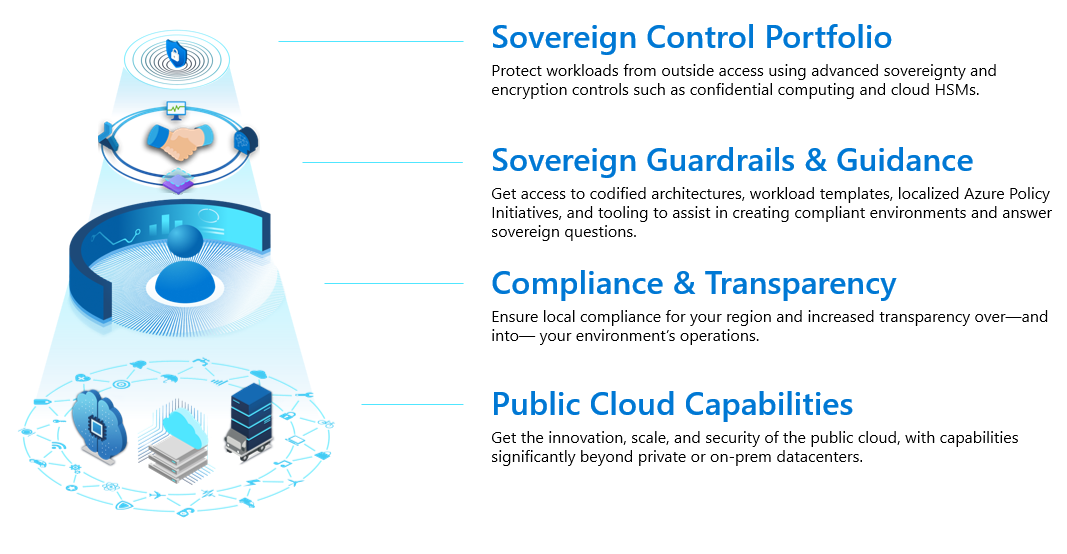Note
Access to this page requires authorization. You can try signing in or changing directories.
Access to this page requires authorization. You can try changing directories.
Important
This content is archived and is not being updated. For the latest documentation, go to What's new in Microsoft Cloud for Sovereignty. For the latest release plans, go to Dynamics 365, Power Platform, and Cloud for Industry release plans.
Important
The 2024 release wave 1 plan covers all new functionalities planned to be delivered to market from April 2024 to September 2024. In this article, you'll find the product overview and what's new and planned for Microsoft Cloud for Sovereignty.
Overview
The Microsoft Cloud for Sovereignty enables governments to build and digitally transform workloads in Microsoft Cloud while meeting many of their specific compliance, security, and policy requirements. Microsoft Cloud for Sovereignty creates software boundaries in the cloud to establish the extra protection governments require, using hardware-based confidentiality and encryption controls.
Adopting cloud computing while meeting digital sovereignty requirements is complex and can differ between organizations, industries, and geographies. Microsoft Cloud for Sovereignty addresses the sovereignty needs of government organizations. Further, Microsoft Cloud for Sovereignty is customizable and adheres to evolving local policies and regulatory requirements around the handling of data. Governments need not choose between digital innovation and control over their data and digital workloads. They can implement secure, consistent, and compliant environments and adhere to evolving local regulations while taking full advantage of the cloud.
The benefits and value of running your applications in the Azure public cloud are substantial and include scalability, elasticity, resiliency, compliance, agility, and unmatched cybersecurity. The article Why sovereignty in the Microsoft public cloud? explains the benefits and value of running your applications in the Azure public cloud. With Microsoft Cloud for Sovereignty, you can meet digital sovereignty and compliance requirements and still gain the benefits of the public cloud. Cloud for Sovereignty supports both greenfield scenarios, such as migrating on-premises workloads to the cloud, and brownfield implementations, such as aiming to improve the digital sovereignty and compliance of existing cloud workloads.
Microsoft Cloud for Sovereignty provides capabilities across different layers.
- Built on top of the Azure public cloud capabilities.
- Regulatory compliance and transparency into the cloud operator's activities.
- Sovereign guardrails through codified architecture, workload templates, localized Azure Policy Initiatives, tooling, and guidance.
- Advanced sovereign control services like Azure Confidential Computing and Azure Key Vault Managed HSM.

Investment areas

Compliance and transparency
Governments require confidence in the security and privacy of their data and the ability to keep innovating while protecting that data. They must also be able to meet their legislative or regulatory obligations and have more insights into the cloud operator's activities.
Microsoft Cloud for Sovereignty builds on top of the compliance and transparency capabilities that Microsoft already provides. Eligible customers can also take advantage of increased transparency into their environments' operations with tools and programs such as source code review, access to technical data, audit logs, and monitoring reports.
For qualified customers and government agencies, Microsoft Cloud for Sovereignty provides additional transparency into Microsoft activities through transparency logs. Additionally, eligible government agencies can benefit from the Microsoft Government Security Program.
Public cloud capabilities
The hyperscale Microsoft cloud provides innovation, scale, agility, and security far beyond the capacity of private or on-premises data centers. Every day, trillions of security signals are analyzed to provide customers with unparalleled protection against cyber attackers. Advanced security capabilities such as Confidential Computing provide customers strict control over where, how, and by whom their data is accessed. Cloud for Sovereignty builds on the power of the hyperscale cloud to provide the public sector and regulated industry customers with data residency, access controls, and transparency to meet their requirements for data sovereignty across multiple Azure and Microsoft services.
Sovereign guardrails and guidance
Microsoft Cloud for Sovereignty offers guidance to support customers in configuring and operating their environments. In addition to leveraging existing concepts and services such as Infrastructure as Code and Azure Policy as Code, it provides access to codified architectures, workload templates, and tools to help create environments that comply with sovereignty, privacy, and regulatory requirements. Additionally, Cloud for Sovereignty reduces the complexity of cloud implementations by providing automation and tooling that make the process simpler, predictable, and repeatable by design.
To learn more about the entire set of capabilities being delivered during this release wave, check out the release plan for Microsoft Cloud for Sovereignty below: